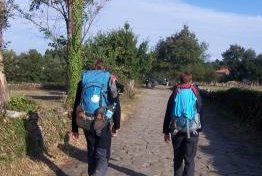
It was about 5km outside of Sarria that I spoke to my first proper Pilgrim, or Perigrino as they are locally known. I was feeling pretty good having decided to walk the last 120km of the Pilgrimage Route to qualify for my Compestela and properly ‘tick off’ this world heritage site.
The South Korean Pergirno asked me “Where did you start walking from?”
“Sarria, I only just started, but I feel good an hour into the pilgrimage. How about you, where did you start?”
“Paris”
“Paris!”
“Yes, I started 3 months ago at Notre Dame”
We walked on talking, we passed a few full pilgrim hostels before eventually finding one with space. We ended up having to share a double mattress on the floor in a room crammed with 30 other perigrinos. Later settling down to a rather limp looking steak, I talked about how there was no hot water in the single shower for all 30+ of us.
A German on the next table turned to me
“Welcome to the Camino!”
And this was how life progressed for the next 3 days. Endlessly meeting and talking to a huge array of people; each with their own reasons for doing the Pilgrimage; some wanted a break from everyday stresses to sort out their direction in life; some for religious reasons and many just wanted to walk for the experience. I met and spoke to people from all over the world, but liberal European holiday allowances and the location meant that there were a lot of people from across the continent, but there were also a very healthy array of people from further afield. The official website has some interesting statistics on who walks the camino and from what starting points.
I am not an especially religious person, and not catholic, so the sacred nature of the walk was not so important to me, however it was an exceptionally interesting way to spend a few days. The WHS itself is currently just the Camino Frances, but it would make a lot more sense if other routes were incorporated into this inscription, especially the original Caminos 'del Norte' and 'Primitivo'. Incorporating the routes across Europe would also seem to be a highly logical step, and show this as an exceptionally cohesive entry, rather than somehow suggesting that the Route in France is manifestly different, as is currently suggested by the separate inscriptions.
In terms of sights along the route the main points of interest are mostly bridges and churches, the finest I saw on my short stretch was Santa Maria in Leboreiro which had some impressive frescos. Occasionally the accommodation is of a distinct vintage; my favourite pilgrim hostel was in the hamlet of Ribadiso do Baixo. I wasn't planning to stay there but a sudden downpour mixed with idea of staying in the recently renovated 14th century Hopistal de St Antón, made up my mind for me, it felt like I was truly getting the experience that I had come for, a bottle of Galician Albarino and the company of some Belgians just added to the enjoyable atmosphere.
I would thoroughly recommend walking some of the route, even if it is only a few km. Walking from Monte de Gozo (like Fredrik below) would be a good idea, unfortunately the route is not so great as you mostly walk through the sprawling suburbs of Santiago. If you had a day to spare and a good pair of shoes then you could try a longer walk from Arca da Pino/ O Pedrouza. It is about 22km and goes through some nice eucalyptus groves, before climbing up to Monte de Gozo to give a first, but slightly cluttered, view of Santiago, it is a route that is fairly representative of the last 120km of the walk. Just remember to say 'Buen Camino' to those that you walk with and you can be as quiet or talkative as you like.
In terms of logistics the Camino Frances is very well marked for the last 150km with every single turning marked with a yellow arrow. Further from Santiago it is still well marked but not quite as extensively. A map is perhaps not essential, but a list of accommodation on the route and how far it is practically essential. I would give a recommendation to the well written download at caminoguide.net. Accommodation is pretty basic, the best you will get in Pilgrim hostels is similar to a good quality youth hostel, the worst can be just mattresses piled into a 'bed-castle', but they are cheap ranging from free- €10 a night, with municipal ones all priced at €5 (2010). The only other essential pieces of kit are a sleeping bag and a good pair of shoes.
Another useful resources I found is: www.caminodesantiago.me.uk. The forum I found exceptionally useful.
This was an exceptionally rewarding trip for me, and quite different from other visits to WHS. On returning I am very keen to walk more of the route, next time I will certainly allow for a longer period of time to walk, a couple of weeks would give a much better introduction to camino life.
[Rating: Site 7; Experience 9.5 (would have been ten if I walked further)]
Comments
No comments yet.
